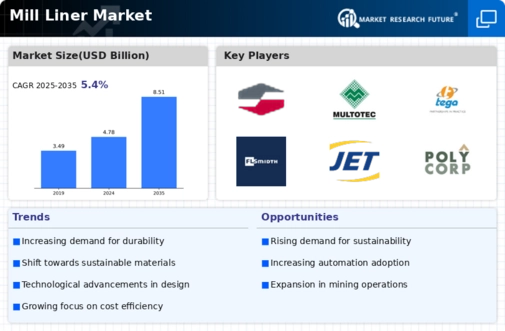Market Trends and Projections
Expansion of the Cement Industry
The expansion of the cement industry is a key driver for the Global Mill Liner Market Industry. As urbanization and construction activities increase, the demand for cement continues to rise. This growth necessitates efficient milling processes to produce high-quality cement, which in turn drives the need for durable mill liners. The cement industry's expansion is expected to significantly contribute to the market's growth, as companies seek to enhance their milling operations. This trend aligns with the overall market projections, indicating a robust future for mill liners as essential components in cement production.
Increasing Focus on Sustainability
Sustainability initiatives are becoming increasingly prominent within the Global Mill Liner Market Industry. Companies are now prioritizing eco-friendly materials and practices in their operations. This shift is driven by regulatory pressures and a growing awareness of environmental impacts. The use of sustainable mill liners not only reduces waste but also enhances operational efficiency. As industries strive to meet sustainability goals, the demand for environmentally friendly mill liners is likely to rise. This trend may contribute to the market's projected CAGR of 5.38% from 2025 to 2035, reflecting a broader commitment to sustainable practices across the sector.
Growing Demand for Mining Operations
The Global Mill Liner Market Industry is experiencing a surge in demand driven by the expansion of mining operations worldwide. As mineral extraction becomes increasingly vital for various industries, the need for efficient milling processes intensifies. In 2024, the market is projected to reach 4.78 USD Billion, reflecting the industry's response to this growing demand. Mining companies are investing in advanced milling technologies, which necessitate high-quality mill liners to enhance performance and longevity. This trend is likely to continue, as the global focus on resource extraction and processing remains strong, thereby propelling the market forward.
Rising Investment in Infrastructure Development
The Global Mill Liner Market Industry is benefiting from increased investments in infrastructure development globally. As nations focus on enhancing their infrastructure, the demand for minerals and materials used in construction rises. This, in turn, drives the need for efficient milling processes, necessitating high-quality mill liners. The ongoing infrastructure projects across various regions are expected to sustain the demand for mill liners, thereby positively impacting the market. The anticipated growth in infrastructure spending is likely to support the market's expansion, aligning with the overall upward trajectory of the industry.
Technological Advancements in Mill Liner Design
Innovations in mill liner design are significantly influencing the Global Mill Liner Market Industry. Enhanced materials and engineering techniques are leading to the development of liners that offer improved wear resistance and efficiency. For instance, the introduction of rubber and composite liners has shown to extend the lifespan of mill liners, reducing downtime and maintenance costs. As companies seek to optimize their milling processes, the adoption of these advanced liners is expected to grow. This trend aligns with the projected market growth, with estimates suggesting a rise to 8.51 USD Billion by 2035, indicating a robust demand for innovative solutions.




















